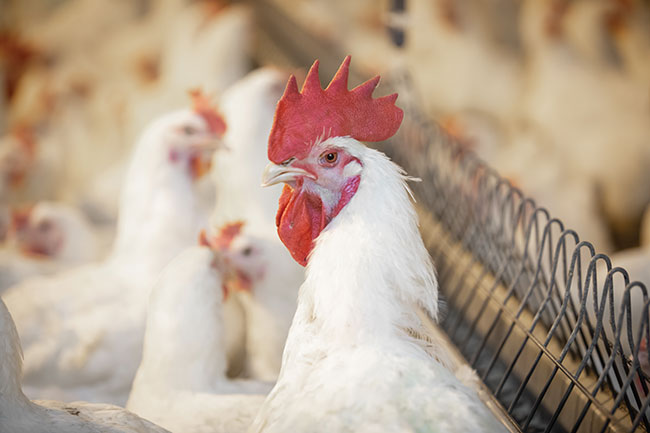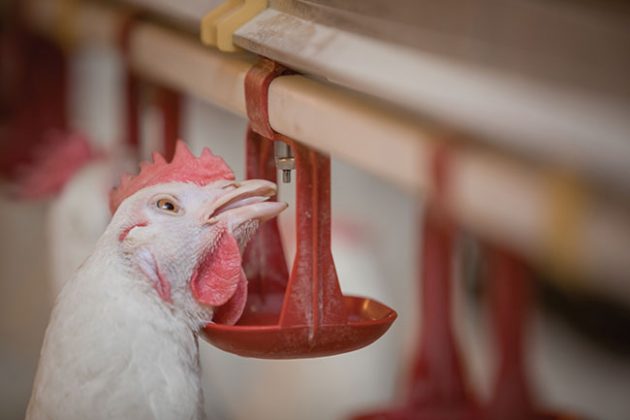
Broiler breeder barn layout
By Paul Welten
Features Barn ManagementHouse design is critical for enabling flocks to reach their genetic potential.
 An exclusion grill on female feeder should create a 45 mm horizontal by 60 mm vertical restriction preventing males from accessing the feeder. The high-profile grill will require enough height of the chain feeder line so that all birds can go under the track to the other side. PHOTO: Cobb-Vantress
An exclusion grill on female feeder should create a 45 mm horizontal by 60 mm vertical restriction preventing males from accessing the feeder. The high-profile grill will require enough height of the chain feeder line so that all birds can go under the track to the other side. PHOTO: Cobb-Vantress
The decision you make for the layout of a poultry breeder house is a very important one. The configuration must operate effectively for many years. There are several layouts, systems and configurations available, but to obtain the full genetic potential of broiler breeders, the house design should be comfortable and attractive to the birds. This article outlines the main factors to consider for the layout of a broiler breeder house in closed controlled production environments.
1. Biosecurity
A rigid biosecurity program is mandatory for health, good welfare outcomes and obtaining the genetic potential of the flock. In general, the house should be designed for easy cleaning and disinfection to prevent and control disease.
Ideally, houses should have concrete floors and washable walls and ceilings. Facilities should have showers so that farm workers enter the house clean. For more information on biosecurity, see Cobb-Vantress’ management guides at cobb-vantress.com.
2. Feed equipment
Improved feed efficiency has contributed to a faster feed clean up time. The feeding system is a very important factor for good production performance. The period from 20 to 30 weeks of age is particularly important due to the fast feed cleanup times. Consider the following parameters:
- Feed should be distributed within three minutes, so all birds are able to eat at the same time. Place additional hoppers on every feed line to ensure a fast feed supply and uniform distribution, especially if the feeder lines are slow (old chain feeders).
- Do feed distribution in dark-out conditions to distribute the feed well and over the whole chain length.
- Time the feed cleanup in minutes from 20 to 30 weeks of age and register this weekly in the data files.
- Birds should be able to eat comfortably (see feeder space in following sections).
- Place feeder lines at least 90 cm apart.
- The most common feed systems are chain and pan feeder. They both work well if they are used correctly.
Chain system
In new houses, install winchable chain feeder systems. These systems can be filled when winched up and the birds can immediately eat when lowered. The house design should consider the extra structural loads of these suspended feeding systems, which includes perching birds.
Ensure 15 cm of feed space per bird. Place a male exclusion system on the female feeder. Grill, bar, plank or wooden boards can be used. An exclusion grill should create a 45 mm horizontal by 60 mm vertical restriction to access the feeder.
Experts recommend placing the hoppers in the middle of the house. However, if they are placed in the front end, use extra dummy hoppers at the back end for fast feed distribution. Use a high-speed capacity of at least 36 m per minute with a frequency regulator to ensure a fast feed distribution.
Pan feeder systems
To calculate the number of birds per feeder, subtract two from the number of holes in the feeder. For example, there should be 14 birds for a feeder with 16 holes. It is very important that the supply of the feed hoppers can easily fill the pans to ensure no pans will be empty.
On every feeder line, place a storage hopper. Ideally, there should be 90 cm between each feeder pan, but 75 cm is the minimum space for birds to have comfortable eating and passing space.
Male feeder system
The males and females should be fed separately. The male feeder system should be winchable so it can be refilled daily to prepare the feed for the following day and should distribute the feed quickly and uniformly.
Traditionally, pan feeders are used for males. But recently, chain feeders against the wall have also become an option. The feed system should be stable and not swing. Install one round pan for eight to 10 males or 10 to 12 males for an oval pan. For a chain feeder, 18 to 20 cm per male is optimal.
The male feeder height should be about 45 to 50 cm from the litter to exclude females and allow males easy access to the system.
3. Water systems
Water is one of the most important nutrients for the birds. Thus, it is important for producers to ensure a clean and consistent water supply.
Bell or nipple drinkers with or without a cup are suitable for any configuration. Experts recommend installing an automatic water flush system for nipples to consistently provide clean, fresh water.
Allocate 60 to 70 females per bell drinker and eight to 10 birds per nipple. In production, use a nipple with a water flow of about 90 ml per minute. For mechanical community nests with slats, install the drinker line over the slats and 60 to 70 cm from the nests.

Use an automatic water flush system for nipple drinkers to provide clean, fresh water.
4. Lighting
Lighting is one of the factors that stimulates the production of broiler breeders. It is important that the light is uniformly distributed through the house (less than 20 per cent variation in lux output) to prevent shadows. This ensures birds uniformly respond to light administration and prevents floor eggs.
When the females are coming into production, gradually increase light intensity with dimmable lighting. LED lighting is very energy efficient, does not flicker and has a longer life than other types of bulbs.
There are many different types but always use high quality LEDs that are designed for poultry houses. A light intensity of > 50 lux and < 100 lux is required in production houses. Use a warmer type of lamp in production (2,000 to 3,000 Kelvin) than in rearing (> 3,000 Kelvin).
In slatted production houses, concentrate the light intensity on the floor area. The nests should be the darkest part of the house. Prevent direct light from entering the house by installing light shutters on fans and inlets. Direct light can influence the birds’ day length and have negative results on production performance.
5. Nests
Mechanical nests automate egg collection. When producers use a mechanical community nest, experts recommend having 200 to 240 birds per nest unit (2.40 meters), depending on the depth of the nest. Install a slat area in front of the nest. To minimize floor eggs, use a 40 per cent slat area and a 60 per cent floor area. The height of the slat should be maximum 45 cm and have a maximum slope of seven degrees.
In mechanical nests with individual holes, allow five birds per hole. For manual nests with individual holes, make it four females per hole.
In Europe, the nest is placed in the middle of the house. Never place the nest against the wall, as generally this is the colder area and is more sensitive to drafts, which can increase the number of floor eggs.
6. Heating and Ventilation
The ventilation system is built on negative pressure in closed houses. To work properly, the house must be well sealed. When working correctly, the ventilation system creates an optimal comfort zone for the birds, delivering a consistent, fresh air supply, removing gasses as well as excess moisture to prevent wet litter.
The air should be evenly distributed in the house using circulation fans. The placement and number producers use will depend on house volume, circulation fan capacity and heater positions.
An ideal effective temperature for broiler breeders is between 21 to 22°C (70 to 72°F). Experts recommend heaters in colder areas to maintain this temperature.
Use calibrated sensors and place them at bird level. In warm climates, producers can use evaporative cooling systems, but only when the temperature is above 27°C (80°F).
Paul Welten is a breeder specialist with Cobb-Vantress, Europe.
Print this page